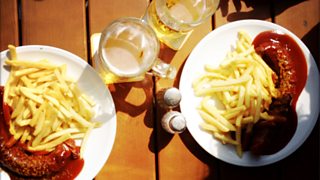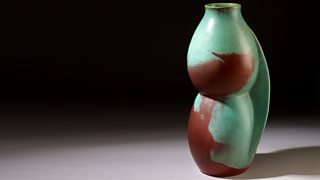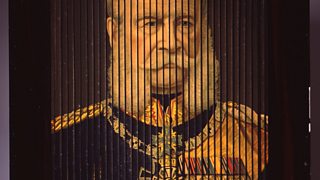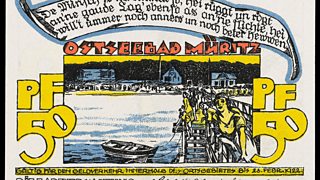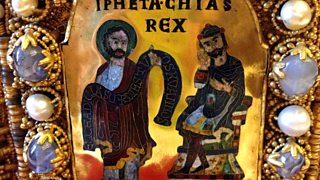A close look at objects from Germany: Memories of a Nation
Vase by Grete Marks
In , Neil MacGregor explains how the Nazis attacked art they viewed as 'entartet' (degenerate). He charts how Joseph Goebbels, Hitler's propaganda minister, led a process designed to purify all German culture, including books, music, paintings and pottery.
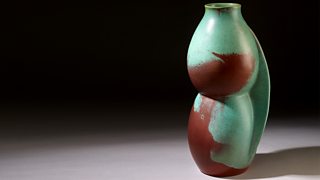
The programme focuses on this vase which Goebbels denounced in his newspaper Der Angriff (The Attack).
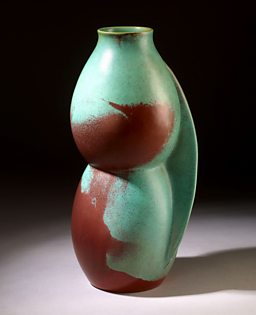
Emergency money
In , Neil MacGregor examines emergency money, known as notgeld, created during World War One and its aftermath.
Small denomination coins began to disappear because their metal was worth more than their face value. Paper notes replaced coins but as cities produced their own money, there was also currency made from porcelain, linen, silk, leather, wood, coal, cotton and playing cards.
Neil also focuses on the crisis of hyperinflation in the early 1920s. At its peak, prices doubled every three and a half days, and in 1923 a 500 million mark note might buy a loaf of bread.

Triple portrait of Wilhelm, Bismarck and Frederick
In , Neil MacGregor charts the career of Otto von Bismarck (1815-98). He was known as the Iron Chancellor and argued that the great questions of the day should be decided by 'iron and blood'.

Neil describes this triple portrait of Kaiser Wilhelm I, Bismarck and Kaiser Frederick III. 'Small strips of wood about a quarter of an inch high stand proud of the surface. They're painted on each side and this means that while in the middle, you see only Kaiser Wilhelm I. If you move to the left you see Bismarck and if you move to the right you see his son, the Crown Prince Frederick.'


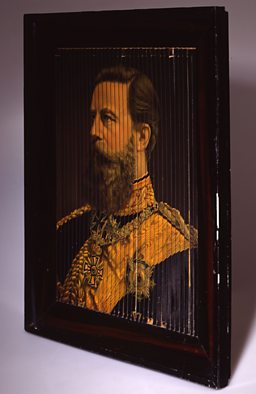
Bauhaus cradle
In , Neil MacGregor focuses on the Bauhaus school of art and design, founded in Weimar in 1919.
'If I had to choose one object to sum up the aesthetic of the Bauhaus it would be this cradle,' says Neil.
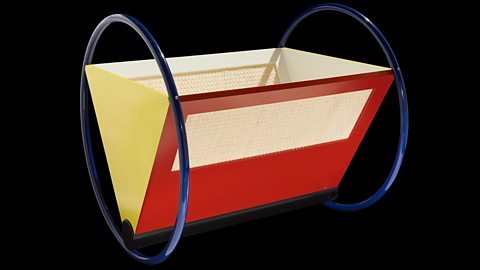
Bauhaus cradle
Neil MacGregor examines a cradle designed by Peter Keler in 1922.
Astronomical compendium
In , Neil MacGregor focuses on the long tradition of German metalwork and he examines this astronomical compendium from 1596.
The smartphone of its day
Silke Ackermann, director of Oxford University's Museum of the History of Science, describes it as "the smartphone of its day". She says: "It has all you would ever want in one box in terms of time-keeping, finding your place on earth, in terms of finding the date. It even has compartments for your drawing instruments."

The Volkswagen Beetle
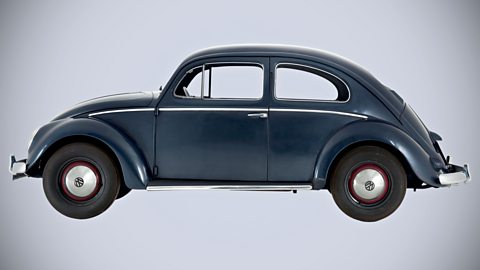
The story of the Beetle
Neil MacGregor explains why the British first produced this classic German car.
DĂĽrer's prints
In , Neil MacGregor focuses on the work of Albrecht DĂĽrer, arguing that he is the defining artist of Germany.
Neil says: 'The print of Melencolia and that of the knight are famous not just for the supreme skill of their making. They have become, in a sense, twin self-portraits of Germany in her two contradictory aspects. The knight representing forceful action, Melencolia, inward-looking contemplation.'


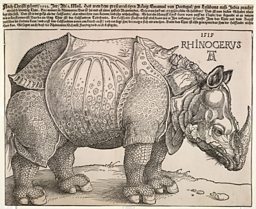
Portrait of Georg Gisze by Holbein
In , Neil MacGregor focuses on the Hansa, the great trading alliance, and the painter Holbein.
'If I had to choose one image to sum up the Hansa in its heyday,' says Neil MacGregor, 'it would be Holbein's 1532 portrait of George Gisze, a Danzig merchant trading in London.'
The painting shows an expensively dressed 33-year-old man, his wealth and status indicated by a vase made of the finest Venetian glass, a small circular brass clock and a Turkish carpet imported from the Levant.

Riemenschneider's sculpture of Luke in limewood
In , Neil MacGregor focuses on the supreme limewood sculptures of Riemenschneider (c1460-1531). 'Possibly the most striking is St Luke who sits on a low stool, head tilted pensively, his right hand resting on his closed Gospel,' Neil says.
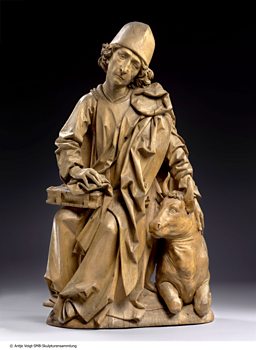
Replica of the Holy Roman Emperor's crown
In , Neil MacGregor visits Aachen to explore the legacy of Charlemagne and examine a fine replica of the Imperial Crown.

Sausage cartoon and beer tankards
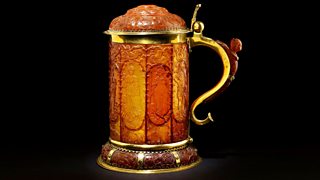
In , Neil MacGregor focuses on two great emblems of Germany's national diet: beer and sausages.

Tischbein’s portrait of Goethe
In , Neil MacGregor focuses on Germany's great national poet Goethe, who was born in 1749.
The most famous portrait in GermanyNeil MacGregor
Neil says, 'I think it is fair to say that it is by far the most famous portrait in the whole of Germany. The artist, Tischbein, shows us Goethe in Italy, dashingly wrapped in a white traveller's cloak wearing a broad-brimmed black hat, sitting on some Roman remains and looking purposefully into the middle distance.'

The Luther Bible
In , Neil MacGregor examines how Luther created the modern German language.
Luther’s 1541 Bible contains portraits of Martin Luther and Johannes Bugenhagen and Luther’s transcription from the 21st psalm and signature.

Hamburg's 10 ducats
In , Neil MacGregor discovers how coins reveal the range and diversity of the Holy Roman Empire.
'Among the cities’ coins, probably the grandest are from Hamburg, the great financial capital of the north, which produced an enormous gold coin, about 35 grams of gold, showing a panorama of the city and its harbour bristling with sailing ships. And above the masts and behind the spires is the word Yahweh, written in Hebrew, to remind you that this prosperous, trading city is defended and blessed by God. The whole ideology of wealthy Hamburg, devoutly Protestant and with a strong Jewish community, is expressed in this one coin.'

Strasbourg clock
In , Neil MacGregor visits Strasbourg, now in France but also a key city in German history.

In 1589, Isaac Habrecht made this domestic version of his masterpiece in Strasbourg Cathedral.

Amber tankard
In , Neil MacGregor visits Kaliningrad, now in Russia but formerly the German city Königsberg.

This splendid amber tankard in the British Museum was made around 1650 in Königsberg.
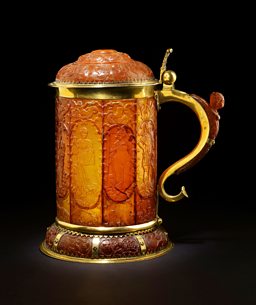

Model of FriedrichstraĂźe Station
In , Neil MacGregor examines the story of the two Germanys, East and West, created in 1949.
It's believed this model of FriedrichstraĂźe Station was used to train the Stasi guards who watched people leaving or entering East Berlin.
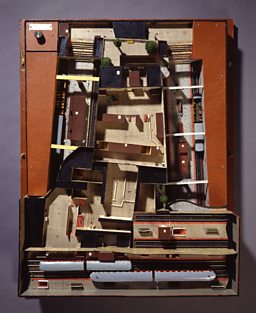

Features about Germany and the objects in this series
-
![]()
Beer riots and sausage snacks demonstrate a devotion to the national diet.
-
![]()
Degenerate art and other facts from this fascinating nation.
-
![]()
See photos and videos of this diverse collection of products and sculptures.
-
![]()
A selection of the most striking objects described by Neil MacGregor.
-
![]()
Neil MacGregor dips into the British Museum's collection of emergency money or notgeld.
-
![]()
See close-up images of the replica Reichskrone now in Aachen.
